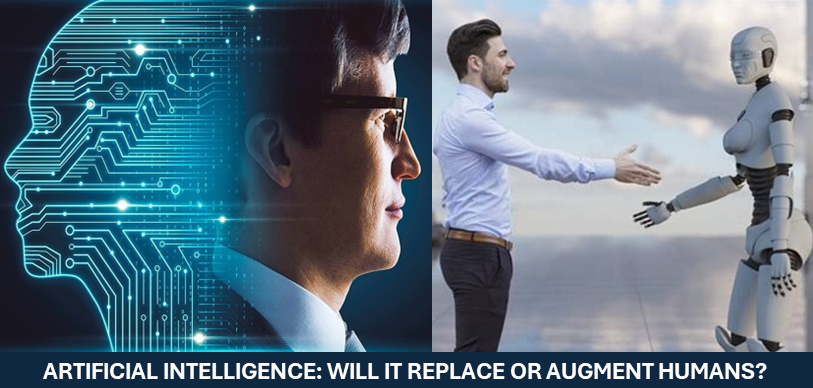AI Should Augment Human Intelligence, Not Replace It
16 Jun, 2024
As the global economy increasingly relies on data to drive value creation and competition, experts predict that large-scale implementation of artificial intelligence (AI) could add an astounding $15.7 trillion to the global economy by 2030. This shift towards AI-driven operations has sparked concerns that intelligent machines will supplant human workers, a trend already observable in sectors such as manufacturing, service delivery, recruitment, and finance. Consequently, many human workers find themselves relegated to lower-paid positions or facing unemployment, leading some to predict that by 2040, the workforce will be dramatically transformed.
However, this narrative of a looming competition between humans and machines is a misconception. The history of labor, particularly since the Industrial Revolution, illustrates a pattern of humans outsourcing repetitive physical tasks to machines. Today, machines have evolved to perform complex cognitive tasks such as mathematical computations, language recognition, and even creative writing. This progression suggests that we are on the verge of outsourcing cognitive functions to AI, with the potential for every job to be automated.
This perspective, viewing the future of work as a zero-sum game where either AI or humans emerge victorious, is fundamentally flawed.
We argue that the real question is not whether AI will replace human workers, but how AI and humans can collaborate to enhance overall intelligence and productivity. The assumption that AI and humans possess equivalent skills and abilities is incorrect. AI systems are exceptionally fast, precise, and consistently rational, but they lack the intuition, emotion, and cultural sensitivity that are intrinsic to human intelligence and essential for effective performance.
Machine Intelligence vs. Human Intelligence
Today’s advanced AI systems are deemed intelligent because they can learn and make decisions based on the data they process. However, this form of intelligence is fundamentally different from human intelligence. AI mimics human actions, emotions, speech, and decision-making processes, aligning with Alan Turing’s philosophy. This imitation is highly beneficial in organizational contexts, where AI can identify informational patterns to optimize job performance. Unlike humans, AI does not experience fatigue and can continuously process data.
AI is ideally suited for lower-level, routine tasks within closed management systems, where external influences are minimal. For example, Amazon employs algorithms as managers on assembly lines, overseeing and even terminating human workers to enhance efficiency and productivity. AI performs these repetitive tasks more accurately than human supervisors.
In contrast, human abilities are far more expansive. Humans can imagine, anticipate, feel, and judge changing situations, shifting focus from short-term to long-term concerns without constant data input. This "authentic intelligence" is crucial in open management systems, where interactions with the external environment demand adaptability and creativity in vision and strategy formulation.
Although Artificial Intelligence (AI1) and Authentic Intelligence (AI2) may seem opposing, they are complementary. In organizational contexts, both forms of intelligence offer unique talents necessary for optimal performance. While individual talent can win games, teams win championships. The future of intelligent work lies in combining AI1 and AI2, creating Augmented Intelligence (AI3) that enhances efficiency, accuracy, creativity, and proactivity.
The Third Type of AI: Augmented Intelligence
What can AI3 offer that AI1 and AI2 cannot? The second author, Garry Kasparov, provides unique insight as the first human to lose a high-level game to a machine. In 1997, Kasparov lost to IBM’s Deep Blue, prompting him to rethink chess as a collaborative effort between humans and AI. In 1998, Kasparov played "advanced chess," partnering with a PC against Veselin Topalov. The match ended in a 3-3 draw, highlighting how AI can complement human strategic planning by handling calculations.
In 2005, Playchess.com hosted a “freestyle” chess tournament where teams of humans and computers competed. Surprisingly, two amateur American players using three computers won, demonstrating that the interaction process between humans and AI determines the partnership's efficiency. As Kasparov noted, “Weak human + machine + better process was superior to a strong computer alone and, more remarkably, superior to a strong human + machine + inferior process.”
Strategic Recommendations for Integrating AI
Our vision for AI's role starkly contrasts with the zero-sum predictions. We view AI-driven productivity and automation of routine cognitive tasks as beneficial. New technologies initially disrupt but reveal their true value over time. However, proactive integration of AI with human intelligence is crucial, rather than passively waiting for change.
To effectively integrate AI:
-
Embrace the New Diversity: Future teams will increasingly consist of both humans and machines. Leaders must address potential biases and negative dynamics, ensuring seamless collaboration between human and AI team members. This new diversity requires an understanding of the psychological dynamics at play and proactive measures to foster trust and cooperation.
-
Develop Inclusive Leadership: Future leaders must excel in aligning human and AI efforts, transforming themselves into coordinators and coaches of diverse teams. This skill set includes understanding both the strengths and limitations of AI and leveraging them to complement human capabilities.
-
Manage Team Processes Effectively: Human oversight is essential in managing team dynamics, understanding AI capabilities, and making strategic decisions to leverage AI for optimal performance. Education and training in AI functionalities and applications are vital for leaders to make informed decisions.
Augmented Intelligence (AI3) represents the future of intelligent work. It envisions a collaborative workforce where humans and machines enhance efficiency and well-being. Rather than viewing AI as a threat, we should see it as an opportunity to augment human capabilities, ensuring a more productive and fulfilling future of work. This approach not only improves efficiency but also enhances human well-being by allowing workers to focus on more creative and strategic tasks, thereby enriching the overall work experience.
By fostering a synergistic relationship between human and machine intelligence, we can create a future where technology serves humanity, enhancing our capabilities and enriching our lives. This collaborative effort is essential for achieving sustainable growth and innovation in the modern economy.
Himanshu Pandey
Software Enginner

